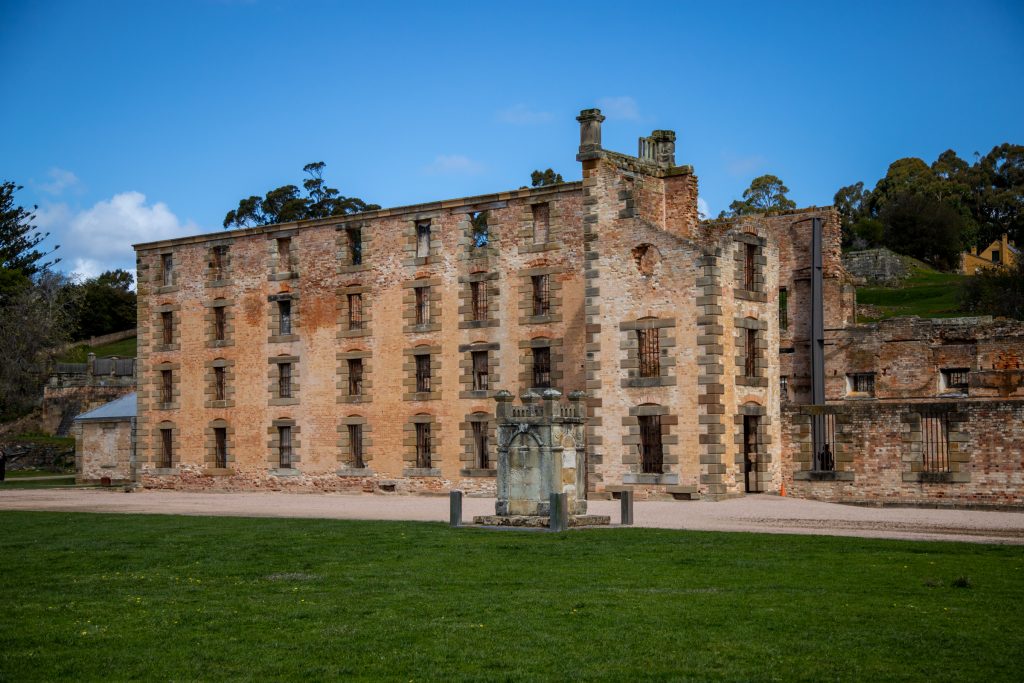Port Arthur Historic Site in Tasmania is a captivating destination that offers a glimpse into Australia’s dark past. As one of the country’s most significant convict sites, Port Arthur served as a penal settlement during the 19th century. With its rich historical background and well-preserved buildings, this site stands as a testament to the lives of the thousands who were imprisoned here. Whether you are a history enthusiast, a curious traveler, or simply seeking a unique experience, exploring the Port Arthur Historic Site will transport you back in time, providing a profound understanding of Australia’s colonial history.

1. Introduction to the Port Arthur Historic Site
1.1 Overview of Port Arthur
Nestled on the picturesque Tasman Peninsula in Tasmania, Australia, lies the remarkable Port Arthur Historic Site. This former convict settlement is a haunting reminder of the country’s dark past. At its peak, Port Arthur was not only a prison but also a self-sufficient township, housing more than 1,000 convicts and various administrative buildings. Today, it stands as a UNESCO World Heritage site, attracting visitors from all over the world who come to explore its rich history and soak in its eerie atmosphere.
1.2 Importance and Recognition
The Port Arthur Historic Site holds immense historical significance for Australia. It played a crucial role in the country’s penal system during the 19th century, being one of the most extensive and formidable convict settlements. Its significance reaches beyond Australia, as it serves as a testament to the hardships endured by convicts and the early colonial history of the country. The site has been recognized for its historical value and has been meticulously preserved to ensure that future generations can bear witness to this haunting chapter of Australian history.
2. Historical Background of Port Arthur
2.1 Early Settlement and Purpose
Port Arthur was established as a timber station in 1830, but its purpose quickly shifted when it was chosen as the site for a secondary punishment settlement. Convicts who had committed further offenses while serving their original sentences were sent to Port Arthur to endure harsher conditions and hard labor. The isolated location, surrounded by treacherous seas and dense forests, made it an ideal place to contain and control prisoners.
2.2 Development and Expansion
Under the leadership of several influential administrators, including the notorious Alexander Maconochie and the progressive Charles O’Hara Booth, Port Arthur underwent significant development and expansion. It transformed from a rudimentary penal station to a self-sufficient settlement with its own industries, including shipbuilding, shoemaking, and agriculture. With its well-designed infrastructure and innovative penal practices, Port Arthur became a model for future penitentiaries.

3. Key Features and Buildings at the Site
3.1 Penitentiary Building
One of the most iconic structures at the Port Arthur Historic Site is the imposing Penitentiary Building. This three-story sandstone structure once housed hundreds of convicts, serving as their barracks and workplace. Today, its ruins stand as a stark reminder of the harsh conditions endured by the prisoners.
3.2 Separate Prison
The Separate Prison, also known as the “Model Prison,” was a revolutionary penitentiary designed to enforce strict discipline and reform convicts through solitary confinement. Its unique radial design allowed guards to monitor all the cells from a central point, ensuring constant surveillance and minimal interaction between prisoners. The silent and somber atmosphere of the Separate Prison still sends shivers down the spines of visitors.
3.3 Church and Chaplain’s Residence
In contrast to the strictness of the penal buildings, the beautifully restored Church and Chaplain’s Residence offer a glimpse into the spiritual aspect of life at Port Arthur. These elegant buildings provided a place of solace and worship for both convicts and free settlers, reflecting the importance of religion in the lives of the people within the settlement.
4. Life at Port Arthur for Convicts
4.1 Convict Labor and Punishment
Life at Port Arthur for convicts was grueling and filled with hard labor. Forced to work in chain gangs, convicts toiled in various industries, such as logging, boat building, and stone cutting. Punishments for misbehavior were severe, ranging from floggings and extended periods of solitary confinement in the Separate Prison to hard labor in the coal mines. The constant threat of punishment loomed over the convicts, creating an atmosphere of fear and control.
4.2 Living Conditions and Daily Routine
Living conditions at Port Arthur were harsh and oppressive. The convicts slept in crowded dormitories with limited privacy and endured meager rations. Their daily routine was strictly regimented, with early morning musters, hours of hard labor, and minimal leisure time. Despite the challenging circumstances, some convicts managed to find solace in creative outlets like writing, painting, and even gardening, leaving behind artifacts that bear witness to their aspiration for a better life.
5. Notable Events and Tragedies at Port Arthur
5.1 The Port Arthur Massacre
When we think of Port Arthur, one tragic event immediately comes to mind – the Port Arthur Massacre. In 1996, a gunman opened fire at the historic site, resulting in the loss of 35 innocent lives. This horrifying event shook the nation and led to significant changes in gun control laws in Australia. Today, the scars of that day can still be felt at Port Arthur, reminding us of the fragility of life and the need for increased vigilance.
5.2 Escapes and Attempted Breakouts
Port Arthur wasn’t just home to convicts, but also to some enterprising individuals who sought freedom. Over the years, there were several escape attempts by inmates, some successful and others not so much. These tales of daring breakouts add another layer of intrigue to the site’s history. From makeshift rafts to disguises, these convicts showed that where there’s a will, there’s often a way.
6. Preservation and Restoration Efforts at the Site
6.1 Conservation and Historical Significance
Preserving the rich history and heritage of Port Arthur is no easy task. However, the dedicated efforts of historians, archaeologists, and conservationists have ensured that this significant site remains intact. The site’s historical significance extends beyond the convict era, encompassing the indigenous heritage and later periods of use. By maintaining and protecting the structures and artifacts, we can continue to learn from the past and appreciate the stories it holds.
6.2 Restoration Projects and Challenges
Restoring a site as extensive and complex as Port Arthur is a constant endeavor. While some structures have been faithfully restored to their former glory, others still lay in ruins, serving as a reminder of the site’s tumultuous history. The challenges faced by restoration teams range from weathering and erosion to limited resources and the ever-present question of historical accuracy. Balancing preservation and presentation is a delicate dance that requires careful planning and expertise.
7. Visitor Experience and Tourism at Port Arthur
7.1 Guided Tours and Interpretive Programs
Visiting Port Arthur is an immersive experience that takes you on a journey through Australia’s past. Guided tours and interpretive programs bring the site to life, with knowledgeable guides sharing fascinating stories and insights. From guided walks through the atmospheric ruins to immersive experiences that recreate life as a convict, visitors have the opportunity to step back in time and gain a deeper understanding of this unique part of Tasmania’s history.
7.2 Attractions and Activities for Visitors
Beyond the historical significance, Port Arthur offers a range of attractions and activities for visitors of all ages. From tranquil gardens and picturesque landscapes to informative museums and art exhibits, there’s something to pique everyone’s interest. For the adventurous souls, there are even ghost tours that explore the site’s spooky reputation and eerie legends. Whether you come for the history or the hauntings, Port Arthur offers a well-rounded and captivating visitor experience.
8. Conclusion and Significance of the Port Arthur Historic Site in Tasmania
Port Arthur’s significance as a historic site cannot be overstated. It serves as a stark reminder of Australia’s convict past and the immense hardships endured by those who were sent there. From tragedies like the Port Arthur Massacre to tales of escape and resilience, this site encapsulates the breadth of human experience. As a destination for both locals and tourists, Port Arthur offers a unique opportunity to reflect on the past, learn from it, and appreciate the progress that has been made since those dark days.
8. Conclusion and Significance of the Port Arthur Historic Site in Tasmania
Visiting the Port Arthur Historic Site in Tasmania is not only an opportunity to delve into the compelling history of Australia’s convict past but also an experience that leaves a lasting impact. The preservation and restoration efforts have allowed this site to stand as a poignant reminder of the hardships endured by those who were once imprisoned here. By exploring the key features, understanding the daily life of convicts, and reflecting on the tragic events that unfolded, visitors gain a deeper appreciation and empathy for the past. The Port Arthur Historic Site serves as a crucial testament to the resilience and strength of the human spirit, and its significance cannot be overstated.
FAQ
1. Can I visit the Port Arthur Historic Site?
Yes, the Port Arthur Historic Site is open to visitors. It is a popular tourist attraction in Tasmania. However, it is advisable to check the official website or contact the site directly for the most up-to-date information on visiting hours and any restrictions that may be in place.
2. Are guided tours available at the Port Arthur Historic Site?
Yes, guided tours are available at the Port Arthur Historic Site. Knowledgeable guides provide informative and engaging narratives, offering insights into the history, architecture, and stories associated with the site. Guided tours can enhance your experience and provide a deeper understanding of the convict era and the significance of the site.
3. Is there an admission fee to enter the Port Arthur Historic Site?
Yes, there is an admission fee to enter the Port Arthur Historic Site. The fee contributes to the ongoing preservation, conservation, and maintenance of the site. Various ticket options are available, including day passes and bundled packages that may include additional attractions or activities within the site.
4. Can I bring children to the Port Arthur Historic Site?
Yes, children are welcome at the Port Arthur Historic Site. It can be a valuable educational experience for children to learn about Australia’s history. However, parents or guardians should be mindful of the site’s nature, which includes stories and remnants of a penal colony. Some areas or exhibits may not be suitable for young children, so it is recommended to review the site’s guidelines and plan your visit accordingly.


























